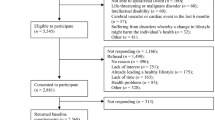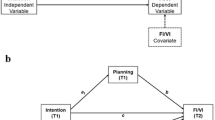Abstract
Background: The effects of tailored intervention on multiple behaviors and possible moderators of tailoring effects have not yet been sufficiently demonstrated.Purpose: The purpose of this study was to examine the effectiveness of a computer-tailored intervention on smoking; physical activity; and fruit, vegetable, and fat intake; and to test potential moderators of the effectiveness (BMI, age, SES, gender, motivation, and the number of behaviors for which respondents met the recommendations from national guidelines).Methods: Respondents were randomly assigned to a tailored intervention group, receiving one tailored letter on all of these behaviors, or a control intervention group, receiving one general information letter on all behaviors.Results: Three months after the baseline assessment, the tailored intervention group showed significantly better effects than the control group for all behaviors studied, except for smoking. Notably, the intervention did not enhance the health behaviors, but rather reduced a decline in these behaviors during the 3-month study interval. Effect sizes were small. No moderating factors were found, except for the number of behaviors for which recommendations were met in the tailoring intervention group on fruit consumption. The largest effects of the tailored intervention were found for fruit in respondents who did not meet the recommendations for any behavior (Cohen’s d=0.3).Conclusions: A tailored intervention on multiple behaviors had significant, but limited effects when compared to generic information. The number of bad habits influenced the effects of the tailored intervention on fruit consumption.
Similar content being viewed by others
References
RIVM:Gezondheid op Koers? Volksgezondheid Toekomst Verkenning 2002 (Health on Course? Explore the Future of Public Health 2002). Houten: Bohn Stafleu van Loghum, 2002.
World Health Organization:Diet, Nutrition and the Prevention of Chronic Diseases, WHO Technical Report Series. Geneva: World Health Organization, 2003.
De Vries H, Brug J: Computer-tailored interventions motivating people to adopt health promoting behaviours: Introduction to a new approach.Patient Education and Counseling. 1999,36:99–105.
Skinner C, Campbell M, Rimer B, Curry S, Prochaska J: How effective is tailored print communication.Annals of Behavioral Medicine. 1999,21:290–298.
Kreuter M, Farrell D, Olevitch L, Brennan L:Tailoring Health Messages: Customizing Communication With Computer Technology. Mahwah, NJ: Lawrence Erlbaum Associates, Inc., 2000.
Bock B, Marcus B, Rossi J, Redding C: Motivational readiness for change: Diet, exercise and smoking.American Journal of Health Behavior. 1998,22:248–258.
Emmons K, Marcus B, Linnan L, Rossi J, Abrams D: Mechanisms in multiple risk factor interventions: Smoking, physical activity, and dietary fat intake among manufacturing workers.Preventive Medicine. 1994,23:481–489.
Gillman M, Pinto BM, Tennstedt S, et al.: Relationships of physical activity with dietary behaviors among adults.Preventive Medicine. 2001,32:295–301.
Jakicic J, Wing R, Winters-Hart C: Relationship of physical activity to eating behaviors and weight loss in women.Medicine and Science in Sports and Exercise. 2002,34:1653–1659.
King T, Marcus B, Pinto B, Emmons K, Abrams D: Cognitive-behavioral mediators of changing multiple behaviors: Smoking and a sedentary lifestyle.Preventive Medicine. 1996,25:684–691.
Kremers S, De Bruijn G, Schaalma H, Brug J: Clustering of energy balance-related behaviours and their intrapersonal determinants.Psychology and Health. 2004,19:595–606.
Calfas KJ, Sallis JF, Zabinski M, et al.: Preliminary evaluation of a multicomponent program for nutrition and physical activity change in primary care: PACE + for adults.Preventive Medicine. 2002,34:153–161.
Campbell MK, Tessaro I, DeVellis B, et al.: Effects of a tailored health promotion program for female blue-collar workers: Health works for women.Preventive Medicine. 2002,34:313–323.
Jacobs A, Ammerman A, Ennett A, et al.: Effects of a tailored follow-up intervention on health behaviors, beliefs, and attitudes.Journal of Women’s Health. 2004,13:557–568.
Vandelanotte C, De Bourdeaudhuij I, Sallis JF, Spittaels H, Brug J: Efficacy of sequential or simultaneous interactive computer-tailored interventions for increasing physical activity and decreasing fat intake.Annals of Behavioral Medicine. 2005,29:138–146.
Strecher V, Wang C, Derry H, Wildenhaus K, Johnson C: Tailored interventions for multiple risk behaviors.Health Education Research. 2002,17:619–626.
Brug J, Van Assema P: Differences in use and impact of computer-tailored dietary fat-feedback according to stage of change and education.Appetite. 2000,34:285–293.
Hulshof K, Lowik M, Kok F, et al.: Diet and other lifestyle factors in high and low socio-economic groups (Dutch Nutrition Surveillance System).European Journal of Clinical Nutrition. 1991,45:441–450.
Hulshof K, Brussaard J, Kruizinga A, Telman K, Lowik M: Socio-economic status, dietary intake and 10 y trends: The Dutch National Food Consumption Survey.European Journal of Clinical Nutrition. 2003,57:128–137.
Lantz P, House J, Lepkowski J, et al.: Socioeconomic factors, health behaviors, and mortality: Results from a nationally representative prospective study of US adults.The Journal of the American Medical Association. 1998,279:1703–1708.
Smith A, Smith C: Dietary intake and lifestyle patterns: Correlates with socioeconomic, demographic and environmental factors.Journal of Human Nutrition and Dietetics. 1994,7:283–294.
Baker AH, Wardle J: Sex differences in fruit and vegetable intake in older adults.Appetite. 2003,40:269–275.
Vilhjalmsson R, Kristjansdottir G: Gender differences in physical activity in older children and adolescents: The central role of organized sport.Social Science and Medicine. 2003,56:363–374.
Ooijendijk W, Hildebrandt V, Stiggelbout M (eds):Trendrapport Bewegen en Gezondheid 2000/2001 (Tendency Report Physical Activity and Health 2000/2001). Plantijn Casparie Heerhugowaard: Heerhugowaard, 2002.
Slovinec D’Angelo M, Reid R, Brown K, Pipe A: Gender differences in predictors for long-term smoking cessation following physician advice and nicotine replacement therapy.Canadian Journal of Public Health. 2001,92:418–422.
Wetter D, Kenford S, Smith S, et al.: Gender differences in smoking cessation.Journal of Consulting and Clinical Psychology. 1999,67:555–562.
Osler M, Prescott E, Godtfredsen N, Hein H, Schnohr P: Gender and determinants of smoking cessation: A longitudinal study.Preventive Medicine. 1999,29:27–62.
Voedingscentrum:Zo eet Nederland 1998 (How the Dutch Eat 1998). Den Haag: Voedingscentrum, 1998.
Flegal K, Carroll M, Kuczmarski R, Johnson C: Overweight and obesity in the United States: Prevalence and trends, 1960–1994.International Journal of Obesity. 1998,22:39–47.
Hill JO, Wyatt H, Melanson E: Genetic and environmental contributions to obesity.Medical Clinics of North America. 2000,84:333–345.
Akbartabartoori M, Lean M, Hankey C: Relationship between cigarette smoking, body size and body shape.International Journal of Obesity. 2005,29:236–243.
Sharpe P, Granner M, Hutto B, Ainsworth BE, Cook A: Association of body mass index to meeting physical activity recommendations.American Journal of Health Behavior. 2004,28:522–530.
De Vries H, Mesters I, Van der Steeg H, Honing C: The general public’s information needs and perceptions regarding hereditary cancer: An application of the integrated change model.Patient Education and Counseling. 2005,56:154–160.
De Vries H, Lezwijn J, Hol M, Honing C: Skin cancer prevention: Behaviour and motives of Dutch adolescents.European Journal of Cancer Prevention. 2005,14:39–50.
De Vries H, Mudde A, Leijs I, et al.: The European Smoking Prevention Framework Approach (ESFA): An example of integral prevention.Health Education Research. 2003,18:611–626.
Van Assema P, Brug J, Ronda G, Steenhuis I: The relative validity of a short Dutch questionnaire as a means to categorize adults and adolescents to total and saturated fat intake.Journal of Human Nutrition and Dietetics. 2001,14:377–390.
Van Assema P, Brug J, Ronda G, Steenhuis I, Oenema A: A short Dutch questionnaire to measure fruit and vegetable intake: Relative validity among adults and adolescents.Nutrition and Health. 2002,16:85–106.
Wendel-Vos G, Schuit A, Saris W, Kromhout D: Reproducibility and relative validity of the short questionnaire to assess health enhancing physical activity.Journal of Clinical Epidemiology. 2003,56:1163–1169.
Wendel-Vos W, Schuit J:SQUASH. Short QUestionnaire to ASses Health enhancing physical activity. Centrum voor Chronische ziekten Epidemiologie Rijksinstituut voor Volksgezondheid en Milieu: Bilthoven, 2002, 1–55.
Brug J, Glanz K, Van Assema P, Kok G, Van Breukelen PJP: The impact of computer-tailored feedback and iterative feedback on fat, fruit and vegetable intake.Health Education and Behavior. 1998,25:517–531.
Dijkstra A, De Vries H, Roijackers J: Long-term effectiveness of computer-generated tailored feedback in smoking cessation.Health Education Research. 1998,13:207–214.
Oenema A, Tan F, Brug J: Short-term efficacy of a web-based computer-tailored intervention, main effects and mediators.Annals of Behavioral Medicine. 2005,29:54–63.
Cohen J:Statistical Power Analysis for the Behavioral Sciences. Hillsdale, NJ: Lawrence Earlbaum Associates, Inc., 1988.
Centraal Bureau voor de statistiek (CBS):Onderwijsniveau Beroepsbevolking (Level of Education of the Working Population). 2005, Statline. Retrieved April 20, 2005 from http://statline.cbs.nl/StatWeb.
Green L, Lewis F:Measurement and Evaluation in Health Education and Health Promotion. Palo Alto, CA: Mayfield, 1986.
Kroeze W, Werkman A, Brug J: A systematic review of randomized trials on the effectiveness of computer-tailored education on physical activity and dietary behaviors.Annals of Behavioral Medicine (in press).
Dijkstra A, De Vries H, Roijackers J, Van Breukelen G: Tailoring information to enhance quitting in smokers with low motivation to quit: Three basic efficacy questions.Health Psychology. 1998,17:513–519.
Kremers S, Visscher T, Seidell J, Van Mechelen W, Brug J: Cognitive determinants of energy balance-related behaviours: Measurement issues.Sports Medicine. 2005,35:923–933.
Author information
Authors and Affiliations
Corresponding author
About this article
Cite this article
Smeets, T., Kremers, S.P.J., de Vries, H. et al. Effects of tailored feedback on multiple health behaviors. ann. behav. med. 33, 117–123 (2007). https://doi.org/10.1007/BF02879892
Issue Date:
DOI: https://doi.org/10.1007/BF02879892




